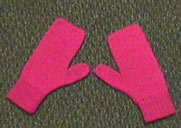
Machine Knit Mittens
This
page has a pattern generator (aka program) to create a pattern to help
you knit a mittens using a single knitting machine. Mine were
knit on a Brother, but you can knit them on a Studio, Bond or Artisan
easily. The hand knit version of the pattern, knit on two needles, is available here.You can make your mittens in any yarn; just enter the gauge and head size in the program, and you'll get the pattern you need.
Main site, blog (read the latest), mitten collection, hat collection and poncho & cape collection.
You must set your browser to run javascript and to accept cookies to run this program. With some browsers, the address bar should also read "http://www.thedietdiary" at the beginning. If the www's aren't there, stick them in!
Characteristics of the mittens:
- Knit from bottom up on a single bed.
- Mock rib hung hem.
- You may vary size the to fit any hand.
- You enter the stitch and row gauge for your yarn.
Remember: Like all patterns spit out by my generators, this is
mostly shaping directions.
The purpose of the generators is to let you be
creative, while eliminating the need to do pesky
calculations.